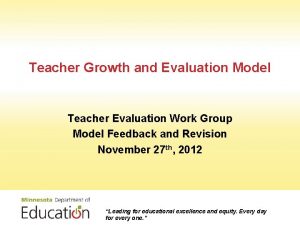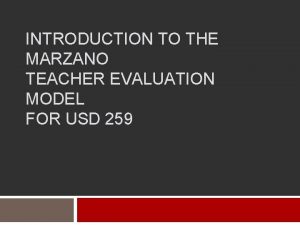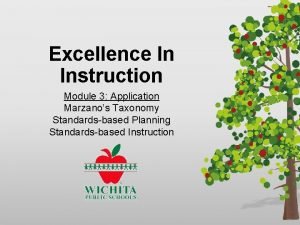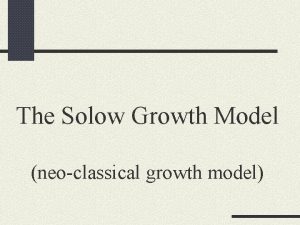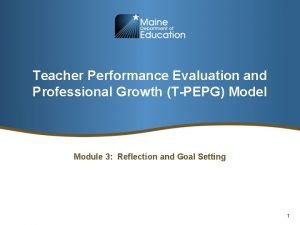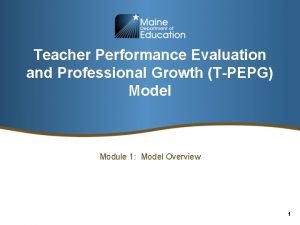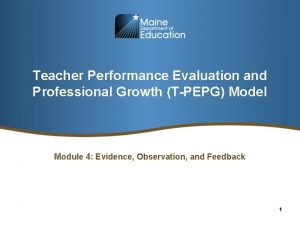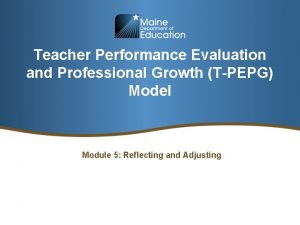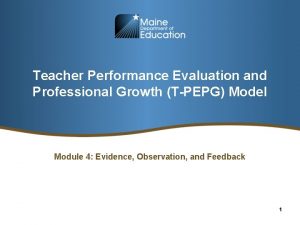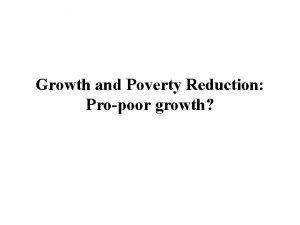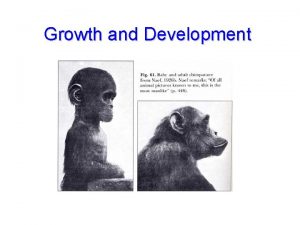Teacher Growth and Evaluation Model Teacher Evaluation Work











- Slides: 11

Teacher Growth and Evaluation Model Teacher Evaluation Work Group Model Feedback and Revision November 27 th, 2012 “Leading for educational excellence and equity. Every day for every one. ”

Meeting Updates TODAY: • Networking via Hope Street Group website • Small and large group discussion, feedback, recommendations December 7 th: • Leadership meeting. Ongoing revision. Online Collaboration Nov 27 th – Dec 13 th • Revision proposals, editing suggestions, discussions December 13 th: • Approval of Default Model for Commissioner. education. state. mn. us 2

Hope Street Group – Collaboration Website • See welcome e-mail sent today – – Login information Change password Update profile Webinar training: Thursday at 4: 30 (Optional) • Guest access • Brief walkthrough education. state. mn. us 3

Draft Model: Student Learning and Achievement Component 3 Groups of Teachers Ongoing Development • Value-added model • Teacher of record • Tested areas • Linkages • Availability of data education. state. mn. us 4

Draft Model: Student Learning and Achievement Component Guide for setting SLG 3 types of goals • Broad Need • Targeted Need • Shared Performance education. state. mn. us 5

Draft Model: Scoring Model for Summative Evaluations • 4 performance categories – – • Rating in each component based on evidence and professional judgment (Holistic Approach) (Note—Value-added=TBD) – – – • • Exemplary— 4 Effective— 3 Development needed— 2 Unsatisfactory— 1 Teacher practice Student learning and achievement Student engagement Component ratings weighted to calculate summative score and final performance category (Numerical Approach) Unsatisfactory final performance rating triggers support under clauses 10 -11 education. state. mn. us 6

Draft Model: Scoring Model for Summative Evaluations Component Weights Component Ratings Teacher Practice 3 . 50 1. 50 4 . 35 1. 40 4 . 15 0. 60 Student Learning and Achievement Student Engagement (Multiply by Weights) (Effective) (Exemplary) Add Products for Summative Score Products 3. 50 3. 5 -4. 0—Exemplary 2. 5 -3. 49—Effective 1. 5 -2. 49—Development Needed 1. 0 -1. 49—Unsatisfactory education. state. mn. us 7

Draft Model: Scoring Model for Summative Evaluations • 4 performance categories – – • Rating in each component based on evidence and professional judgment (Holistic Approach) (Note—Value-added=TBD) – – – • • Exemplary Effective Development needed Unsatisfactory Teacher practice Student learning and achievement Student engagement Component ratings weighted to calculate summative score and final performance category (Numerical Approach) Unsatisfactory final performance rating triggers support under clauses 10 -11 education. state. mn. us 8

Draft Model: Revisions and Clarifying Questions • Primary revisions since November 15 – – – • Edits to performance categories and descriptions and to roles document Removed requirement that summative evaluators be nonprobationary Revised scoring guidelines for student engagement component Removed annual recommendations from peer reviewer(s) Removed option for summative self-evaluation by portfolio in lieu of summative evaluation by a summative evaluator Clarifying Questions? education. state. mn. us 9

Work Group Review and Revision Process • Subcommittee discussions – Clarifying questions – Draft proposals for revisions • Mixed group discussions – Clarifying questions – Review of proposals for revisions from subcommittee discussions – New proposals for revisions Proposed Revisions What are you wanting to change? Why are you wanting to change it? What is the solution you propose? What is the work group’s decision point? • Whole group discussion – Review of proposals for revisions – Approval of proposals for revisions Use the proposal form provided. education. state. mn. us 10

Large Group Review: Prioritize Proposals and Discuss The goal is consensus. (1) This decision is best for students and teachers. (2) I am OK with the group’s decision and will not work against it. • Prioritize proposals for revisions • Review individual proposals – Initial responses (5 -point response scale) – Discussion if needed – Final decision if needed (4 -point response scale) • Approved revisions made and posted at Hope Street website education. state. mn. us 11
 Teacher growth model
Teacher growth model Growth is defined as an increase in
Growth is defined as an increase in Ground tissue
Ground tissue Primary growth and secondary growth in plants
Primary growth and secondary growth in plants Chapter 35 plant structure growth and development
Chapter 35 plant structure growth and development Marzano causal teacher evaluation model
Marzano causal teacher evaluation model Marzano teacher evaluation scale
Marzano teacher evaluation scale Marzano teacher evaluation model
Marzano teacher evaluation model Carothers equation
Carothers equation Geometric growth graph
Geometric growth graph Neoclassical growth theory vs. endogenous growth theory
Neoclassical growth theory vs. endogenous growth theory Difference between organic and inorganic growth
Difference between organic and inorganic growth
